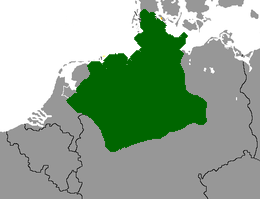

Official European language
Since 1998, the Netherlands has recognized Low Saxon as a language under the European Charter for Regional or Minority Languages. The Low Saxon Covenant came into effect in 2018, whereby the regional governments in the Low Saxon-speaking part of the Netherlands indicate that they are making an effort to preserve and promote Low Saxon, but this is not legally enforceable. Since 1998, Germany has also recognized Low Saxon (Niederdeutsch or Plattdeutsch) under the European Charter for Regional and Minority Languages. In the European Union, Low Saxon is an officially recognized regional language.
History of Low Saxon
History of Low Saxon The origin of the origin of Low Saxon goes back around the year 500 AD. It was the time of the Great Migration when several tribes, including the Germans, poured into the Western Roman Empire.
In the time of the Hanseatic League they could be heard far into the Baltic region.
The western part of the Lower Saxony area has te following dialects with many variations:
West Lower Saxon dialects
Dutch Low Saxon
Westerkwartiers
Gronings
Stellingwerfs
Central Drenthe
South Drenthe
Twents
Twents-Graafschaps
Gelders-Overijssels
Veluws
German Low Saxon
East Frisian Low Saxon
North Low Saxon
Westphalian
Eastphalian

Euregio organization
There are organizations that facilitates the German-Dutch cooperation, including Euregio in the border areas of Overijssel, Achterhoek, German Lower Saxony and Nordrhein Westfalen. Euregio stimulates cooperation between the Netherlands and Germany to increase economic strength and quality of life and to improve the integration of the border area. Living in a border region offers many opportunities: The best of both worlds – and all this at your doorstep! The EUREGIO has been active since 1958 in building and strengthening borderless cooperation in the Dutch-German border area. The basis for this is the cross-border partnership of 129 Dutch and German municipalities, (Land-)Kreise and Water Boards.
A West Lower Saxony dialect
In the article below you can see one Lower Saxon dialect which has common Lower Saxony elelements. This dialect can be understood in from the Eastern part of the Nethlerlands until the Eastern part of de former GDR.
Et Nedersaksisch wördt veural espreuken in et noordoostelike deel van Nederlaand (de provincies Groningen, Drenthe en Overiessel, de Gelderse gebiejen de Veluwe en de Achterhoek, de Stellingwarven in et zuudoosten van Frieslaand, en Urk in Flevolaand) en in et noordelike deel van Duutslaand (onder aandere in Nedersaksen, Westfaolen, Hambörg, Bremen, Sleeswiek-Holstein, Mekelenbörg-Veurpommeren, Saksen-Anhalt en Braandenbörg, oek kleine gedeeltes van et noorden van Hessen en Thüringen spreken van oorsprong Nedersaksisch). Et Nedersaksisch dat in Nederlaand espreuken wördt, wördt tot et West-Nedersaksisch erekend. Et Nedersaksisch uut Duutslaand veur een groot gedeelte oek, mer et oostelike deel völt onder et Oost-Nedersaksisch (oek wel et Oost-Nederduuts eneumd).
Eertieds wördden et Nedersaksisch volop espreuken in et Deense Zuud-Jutlaand, tegenswoordig bin dat der een stuk minder. Oek an de raand van Berlien praotten ze van oorsprong Nedersaksisch, mer mit de verstedeliking en nasionale centralisasie is et dialekt uutestörven. In de noordelike Duutse gebiejen, wat noen Polen, de Russische provincie Koningsbargen, zuudwestelik Litouwen en Estlaand bin, was et Nedersaksisch oek goed vertegenwoordigd. Sinds de verdrieving van et grootste gedeelte van de Duutse bevolking, an et einde van de Tweede Wereldoorlog, wördden et der haost niet meer espreuken. Vandage de dag bin der nog wel een stuk of wat Nedersaksische sprekers buten Nederlaand en Duutslaand in de kustgebiejen van Polen (een minderheid etnische Duutsers); sprekers van et Oostpommers die Pommeren niet uutezet bin, en oek de regio’s rond Bruunsbarg (Braniewo).
